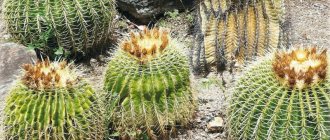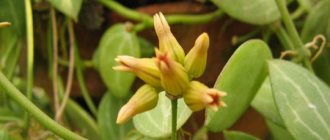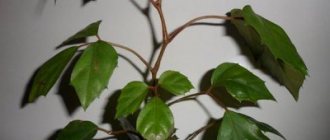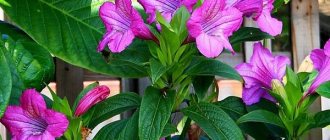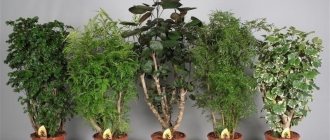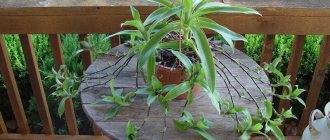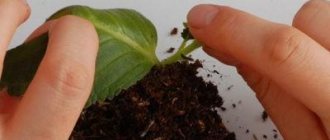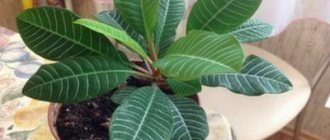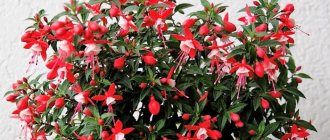Author: Natalya Category: Houseplants Published: June 25, 2018Republished: February 26, 2019Last edits: January 11, 2021
- Diseases and their treatment
- Pereskia grandiflora
Peireskia, or pereskia (lat. Pereskia) is a genus of cacti from Central and South America, whose representatives were first described in 1703 by Charles Plumier. The genus was named in honor of the French scientist Nicolas-Claude de Peyresc. These plants were first assigned to the genus Cactus by Carl Linnaeus, but in 1754 Philip Miller identified them as an independent genus. Today there are 18 species of Peresis, which are represented by both bush-like and tree-like forms. Some pereskia cacti are successfully grown indoors.
Pereskia: flowering leaf cactus
The status of the most ancient cacti among Peresk is disputed, but they are definitely the most original. Unusual bushes with real leaves and romantic flowering are difficult to mistake for relatives of the usual indoor cacti. Dangerous and beautiful spines only emphasize how extravagant this plant is. Not the most undemanding of conditions, pereskias easily shed their legendary leaves. But they still remain easy-to-grow succulents that can easily add variety to home collections.
Pereskia is a flowering deciduous cactus.
Pereskia flowering
Aculeata and the spiny subspecies of deciduous cactus bloom in late spring and summer. It is also very interesting to see how Pereskia Godseffa blooms. Its buds bloom at the end of summer and the beginning of the autumn season.
Perexia flowering differs from other succulents in the shape of its buds
The flowers of these deciduous cacti differ in their shape from other succulents. Pereskia has open star-shaped buds, while other cacti have tubular buds. In the middle of the bud there are many yellow stamens. Usually each flower has 8 lanceolate glossy petals. The diameter of small inflorescences does not exceed 3 centimeters.
Note! After flowering, yellow fruits are formed that can be eaten.
If you properly care for Pereskaya, its flowering will always occur in a timely manner. This exotic deciduous cactus can easily grow in open areas in the summer season, as it is highly resistant to unfavorable climatic conditions. Thanks to its bright glossy leaves and flowers, spiny pereskia will decorate any interior.
Description of the pereska plant
Representatives of the Peresky genus are considered relict and perhaps the most ancient cacti - unusually bright flowering, dangerous spines and graceful leaves. They are allocated to a special subfamily of Pereskieves (Pereskioideae) and are found in nature only in Latin America.
Pereskia are often used as rootstocks for other types of cactus. In Brazil you can enjoy their buds, leaves and a special delicacy - aromatic, unusual, very tasty fruits known as Barbados gooseberries and climbing lemons.
Pereskia, or Peireskia (Pereskia) are distinctive representatives of cacti. These shrubs and trees in nature can reach gigantic sizes and are able to survive in the harshest conditions, storing moisture in the stems. But outwardly they are much closer to herbaceous plants - with deep roots and thin, branched, woody stems. Hidden in the axils of the leaves are beautiful areoles with very large, sharp and hard spines - single or collected in bunches, silver or dark brown.
The true leaves of Peresk are lanceolate-oval, with a pointed tip, reminiscent of laurel leaves. With a length of up to 10 cm, they are shiny, leathery, with different shades of green among species and varieties. They fall off in uncomfortable conditions and during periods of rest, and often fade.
The summer flowering of Pereschi is reminiscent of wild roses and roses thanks to the delicacy of the petals and the lush hemisphere of bright stamens around the very large pistil. Flowers are from 4 cm in diameter, solitary or collected in inflorescences, fragrant, with delicate cream or pink colors.
After flowering, edible, yellowish-reddened fruit cones, up to 2 cm in diameter, begin to develop. Some pereskias can compete with prickly pears in the originality of fruiting, forming entire clusters. After the fruit begins to ripen, the hidden areoles on it begin to swell and grow into new buds or side shoots, as if the fruit is branching at the top.
Pereskia grandiflora.
What does Pereskia look like, what family does it belong to?
Pereskia flowers are members of the Cactus family. Under natural conditions, they are distributed throughout Central and South America, in the form of a large shrub or small tree.
Pereskia spinosa
The culture has strong, straight stems covered with thorns. Reduced leaf blades are dark green in color; when the temperature drops to 10 degrees, they may fall off. With age, the leaves lose their bright color and turn pale.
Common varieties
The indoor flower varieties include the following representatives:
- Pereskia spinosa;
- Pereskia aculeata;
- Pereskia Godseff (godseffiana).
Important! The latter variety is distinguished by pinkish or purple lower leaves and a height of up to 10 m.
Pereskia Godseffa
Types of indoor Persky
Pereskia orange (Pereskia bleo) is a plant with oval, large, matte leaves decorated with a wavy edge and flowers reminiscent of red-orange roses, followed by bright cones of inedible fruits.
Pereskia aculeata is a climbing species that forms very dense bushes with large lanceolate leaves and long spines. Rosehip-like, fragrant, wide-open, pale cream flowers with bright orange stamens cover the bush in a scattering. There are many forms and varieties with reddish leaves.
Webber's Pereskia weberiana.
Pereskia aculeata.
Pereskia grandifolia.
grandiflora is prized for its soft pink, large flowers in clusters of inflorescences, highlighted by dark leaves and very long spines.
Webber's Pereskia weberiana is a very beautiful, densely branching species that is easy to form. Small, bright oval leaves and abundant blooms with snow-white flowers seem strikingly romantic.
In Pereskia, the most outlandish fruits can be found in Pereskia grandifolia, with its fruit clusters consisting of ovaries and stems with intricately curved purple flowers.
Pereskia varieties
Pereskia is one of the most ancient types of cacti. Its peculiarity is the presence of leaf plates, unlike most modern cacti, which grow spines instead.
Pereskia spinosa
This bush got its name in honor of the French scientist N.K. de Peiresca. The name of the plant appears in the diaries of C. Plumier. Pereskia spinosa also has other names: rose cactus or deciduous cactus. The latter option is supported by the presence of leaves and spines growing on the stem.
Pereskia spinosa
This is an evergreen perennial plant. Despite the fact that Pereskia spinosa belongs to the Cactus family, it is similar in appearance to a widely branched shrub with erect stems. Over time, they become woody with brownish-red shiny bark. The plant has a powerful root system.
The height of this shrub can reach 10 meters. Over the course of a year, the shoots grow another 20 centimeters. Not only leaves grow on the branches of Pereskia, but also long spines.
The leaves have an oval or ovoid shape, the length is 3-5 centimeters. They have a smooth edge and a sharp tip. The shiny surface of the sheet plate protects against excessive evaporation of moisture. To care for them, you need to regularly spray them with clean water.
Interesting! Pereskia spinosa bears inedible, juicy fruits with shiny yellow or beige skin. They can have a cone-shaped or round shape. Inside the fruit you can see several large black seeds.
This plant has 17 species. In the wild, large bushes can grow from them, but at home they make beautiful compact plants.
Pereskia Godseffa
Pereschia Godseffiana has thin stems. They are covered with numerous bunches of long black spines. The oval-shaped leaves have a pointed edge. They are on strong short petioles. The length of the leaves of Pereskia Godsef is six centimeters. Their plates have a light green color, the middle is a rich green color. The lower surface may have a pink or purple tint.
Pereskia Godsefa
Pereschia Godseff's flowers are small in size and white or cream in color. This plant can reach ten meters in height. The time to see Pereskia Godseffa bloom is in early summer. The flowers emit a scent that is similar to citrus.
Pereskia Akuleata
Pereskia spinosa has another name - Pereskia aculeata.
Pereskia orange
This species can reach eight meters in length. Stems are woody with olive-colored bark. Their thickness can be 10-15 centimeters. On large leaf plates you can see easily distinguishable veins. The leaves grow on long petioles. Pereskia flowers, 4-5 centimeters in diameter, are orange in color. The cone-shaped fruits have a pineapple smell, but are inedible.
Growing conditions for indoor Peresian
In order not to be disappointed in this unusual cactus, you should approach the selection of conditions with the utmost care. If you provide your Pereski with access to fresh air, the warmth she loves, and bright lighting, there will be no problems with care.
Lighting and placement
Pereskia are among the most light-loving cacti; they do not welcome artificial lighting and bloom only on sunny windowsills. You can even place them on south-facing windows. Direct summer sun will often burn the leaves, but simply moving them away from the glass or moving them to a spot next to a windowsill in high summer will easily correct this problem. In partial shade, the bushes stretch out and do not bloom.
Maintaining the level of lighting for the winter and moving it to a bright window sill is one of the conditions that allows pereskias not to lose all their leaves.
Temperature and ventilation
Pereskias love fresh air. Drafts are not dangerous (unless there is a sharp jump in temperature and the plant does not bloom). It is necessary to ventilate the premises as often as possible. Whenever possible, it is better to place pereskias in the fresh air, choosing warm places protected from precipitation.
In summer, Pereskias feel great in the warmth. When kept indoors, it is better to maintain a temperature of 21 to 23 degrees. In the fresh air or with constant ventilation, pereskias can withstand any heat.
The ideal temperature for wintering pereski is considered to be about 15 degrees Celsius. The temperature should not drop below 10 degrees. Increasing the indicators to the usual indoor ones requires control of lighting, frequent ventilation and impeccable care.
Orange Pereskia (Pereskia bleo).
Similar flowers
Orange Pereskia (lat. Pereskia bleo) stretches from 2 to 8 m in height. Her bush is weakly branched. The bark of young stems is olive-colored. The diameter reaches 15 cm.
- Pereskia Grandiflora , or large-flowered (lat. Pereskia grandiflora) in the wild grows up to 5 m in height and up to 20 cm in diameter. The stem is covered with thorns 2-3 cm long. It is rough and chestnut in color. The leaves are elongated, up to 23 cm in length.
- Pereskia aculeata differs from Godseff's pereskia in having green leaves and being a more pronounced vine. The spines on young shoots are curved, brownish-green, while on older shoots they are straight, rigid and darker. The flowers of this plant are yellow or pinkish-yellow.
- Weber's Pereskia (Pereskia webehana) this species, which forms bushes 1-3 m in height and has a thickened rhizome, is cultivated as a bonsai-type succulent plant. White flowers 1 cm in diameter appear from spring to late summer.
This cactus is perfect for a cottage or apartments with large balconies and south-facing windows. Pereskia Godseffa loves fresh air and long sunny days. A beautiful shrub with fleshy leaves, easy to care for, pleases gardeners for many years.
If you find an error, please select a piece of text and press Ctrl+Enter.
Caring for Pereskaya at home
Careful watering, rare fertilizing and attention - these are all the measures that pereskias need to maintain their decorative appearance.
Watering and air humidity
For pereskia, active watering is carried out only during the growth period, but it is better not to completely dry out the substrate even in winter, because during drought, pereskia sheds its leaves. In spring and summer, the soil is allowed to dry in the upper third of the pot, immediately draining the excess from the trays. In winter, watering is reduced. You need to change the humidity gradually.
Despite the dislike of high air humidity, to maintain the decorative appearance of the leaves, it is better to include “refreshing” sprays with warm water in the care of pereskies. The higher the air temperature, the more often they need to be carried out, up to daily in the summer. Dust is removed by washing the leaves; wiping destroys the protective coating.
Top dressing and fertilizer composition
Fertilizers are applied to this cactus only in liquid form and only during the period of active growth. One feeding per month with special fertilizers for succulents and cacti is enough.
Trimming and shaping pereski
Even bonsai can be easily formed from Pereskaya. They tolerate pruning well in spring and summer, provided that at least 1-2 internodes are left on the shoots.
Young pereskias can be replanted several times a year.
Transplantation, containers and substrate
Pereskia requires a very loose substrate with a pH of about 7.0. To the usual soil mixture for cacti and succulents, it is worth adding 40-50% loosening additives that guarantee high air permeability of the soil (coarse sand, perlite, stone chips, gravel).
This cactus is replanted only as needed - as soon as the roots fill the space of the pot. Young cacti can be replanted several times a year; adults often do not need to be “touched” for several years.
For Pereskaya, fairly deep containers are used, corresponding to the unusually powerful root system for cacti. A high drainage layer is required.
Pereskia do not tolerate contact with roots; they are carefully handled. Watering after transplantation should be extremely careful until rapid growth begins.
How does pereskia reproduce?
Gardeners use two methods of propagation: seeds and cuttings. Both methods help to obtain healthy and viable seedlings.
Germination of seeds
It begins with the preparation of boxes filled with sand and peat mixture. Sowing work is carried out in early spring; planted seeds require regular watering.
After planting, the containers are covered with plastic film, and the improvised greenhouse is periodically ventilated.
Important! If you care properly during this period, the first shoots will appear by the end of the month.
Rooting cuttings
Healthy shoots are selected for cuttings; the procedure is carried out in spring or June. The branches are cut into small cuttings, and the cut areas are treated with charcoal powder.
Later, the trimmings are placed in boxes with a perlite-peat mixture. The boxes are covered with polyethylene, periodically watered and ventilated.
Important! In a few weeks, young shoots will appear that can develop without film.
Diseases, pests and problems in growing
Pereskia are one of the most sensitive cacti to waterlogging and are extremely susceptible to rot. If there are any signs of damage to the stems, root collar or roots, you must immediately adjust the conditions and care and begin treating with fungicides. An emergency transplant most often leads to death.
Of the pests, all insects that love dry conditions are terrible for the Peresian - spider mites, mealybugs and thrips. It is better to fight them immediately with insecticides.
Fading or dropping leaves, stretching shoots always indicate an excess or lack of light. Growth disturbances most often occur due to irregularities in watering.
At home, pereskia is most often propagated by stem cuttings.
Diseases and pests
If there is too much liquid, especially in cold weather, the neck and roots begin to rot. This can happen in the absence of drainage or insufficient amount of it. To prevent such a problem, it is necessary to carefully monitor watering so that it is not excessive.
A softened mold may appear in certain areas of the stem; this disease is called gray rot. This disease occurs from high air humidity and when circulation does not occur. To combat the disease, it is necessary to change the conditions of detention, as well as treat the plant with special compounds.
Mealybugs extract sap from the leaves and all stems of the plant, and eventually it dies. To combat such pests, they are removed using a hard brush. If there are a lot of plants, then it is necessary to carry out additional treatment with special means that can prevent the development of cocoons.
There are also other types of pests, for example, mites or thrips, they can infect all plant organs, flowers, leaves, and stems. To combat this problem, pereskia is treated with special means.
Peresian breeding
Growing pereskia from seeds is very difficult due to low germination and extreme sensitivity of seedlings to any increase in humidity. Sowing is carried out to a depth of 1 cm, in very light soil. At temperatures up to 21 degrees, plants are kept in light humidity under a hood. Diving is carried out very carefully in the 4-leaf phase, but it is better to sow directly into individual containers.
At home, pereskia is most often propagated by stem cuttings. You can cut them in spring and summer, using pieces of stems with 1-2 internodes. It is easier to root cuttings in sandy soil under a cover, at a temperature of 25 degrees. When rooting in water, you need to plant the cuttings very carefully, trying not to come into contact with the roots.
Reproduction of Pereskia
Pereskia is propagated by seed and cuttings. Pereskia seeds are sown in the spring in a container with loose substrate and kept until germination at a temperature of 20-22 ºC. When the seeds germinate, the crops are placed in a bright, warm place, but at first they are protected from direct sunlight. Strengthened and grown seedlings are planted in separate pots.
For the cutting procedure in spring or summer, cuttings are cut from the stems of Pereska, planted in a peat or perlite substrate and covered with a transparent cap to create greenhouse conditions. Rooting occurs best at a temperature of 25-28 ºC. You can grow roots by placing the cuttings not in the substrate, but in a container with water: under such conditions, roots will appear within three weeks. Rooted cuttings are planted in pots.
Description of the cactus Pereskia aculeata
Pereskia aculeata is a species of fast-growing vines of the Pereskia genus of the Cactus family. Also known as Pereskia prickly and Barbados gooseberry. A bushy and climbing plant, it can reach a length of 10 m. It has a fleshy, highly branched stem, reaching a diameter of up to 1.5 cm. The leaves are oval-shaped, dark green, up to 9 cm long, and about 4 cm wide. During Over time, the leaves fall off, and in their place there remain dark areoles with 1-3 hard spines.
The species is native to the Antilles, Panama and the northern shores of South America. But it is grown in many countries: tropical America, Australia, Israel, India, California, the Philippines and the Hawaiian Islands. The fruits of the plant are eaten, and the leaves are used to make salads. Pereskia thorny is also used to decorate hedges.
The Pereskia genus was first described in 1703 by Charles Plumier. The name of the genus was given in honor of the French scientist Nicolas-Claude de Peiresc. Carl Linnaeus placed these plants in the genus Cactus, and in 1754 Philip Miller placed them in the genus Pereskia.


